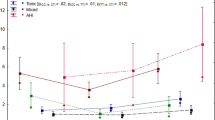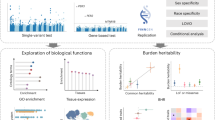Abstract
HLA-DQB1 typing was performed in 60 Caucasian subjects with sleepwalking (SW) disorder and their families and 60 ethnically matched subjects without any diagnosed sleep disorder. A total of 21 sleepwalkers (35.0%) were DQB1*0501 positive vs eight (13.3%) controls (P=0.0056; odds ratio=3.5, 95% CI=1.4–8.7). The family data for all HLA subtypes were further assessed for allelic association with SW using the transmission–disequilibrium test. A significant excess transmission was observed for DQB1*05 and *04 alleles in familial cases, strongly suggesting that a DQB1 polymorphic amino acid might be more tightly associated than any single allele. Sequence screening revealed that Ser74 in the second exon shared by all DQB1*05 and *04 was 20 times transmitted against 4 times non-transmitted (P=0.001) in familial cases of SW. Thus, together with narcolepsy and REM sleep behavior disorder, these findings suggest that specific DQB1 genes are implicated in disorders of motor control during sleep.
This is a preview of subscription content, access via your institution
Access options
Subscribe to this journal
Receive 12 print issues and online access
$259.00 per year
only $21.58 per issue
Buy this article
- Purchase on Springer Link
- Instant access to full article PDF
Prices may be subject to local taxes which are calculated during checkout
Similar content being viewed by others
References
Hublin C, Kaprio J, Partinen M, Heikkilä K, Koskenvuo M . Prevalence and genetics of sleepwalking: a population-based twin study. Neurology 1997; 48: 177–181.
Abe K, Shimakawa M . Genetic and developmental aspects of sleepwalking and teethgrinding. Acta Paedopsychiatrica 1966; 33: 339–344.
Guilleminault C . Sleepwalking and night terror. In: Kryger M, Roth T, Dement WC (eds). Principles and Practice of Sleep Medicine. WB Saanders: Philadelphia, 1989, pp 379–384.
Diagnostic Classification Steering Committee, Thorpy MJ, Chairman. International Classification of Sleep Disorders: Diagnostic and Coding Manual. American Sleep Disorders Association: Rochester, MN, 1990.
Broughton RJ . Sleep disorders: disorders of arousal? Science 1968; 159: 1070–1078.
Kales A, Soldatos CR, Bixler EO, Ladda RL, Charney DS, Weber G et al. Hereditary factors in sleepwalking and night terrors. Br J Psychiatry 1980; 137: 111–118.
Kales A, Soldatos CR, Caldwell AB, Kales JD, Humphrey 2nd FJ, Charney DS et al. Somnambulism. Clinical characteristics and personality patterns. Arch Gen Psychiatry 1980; 37: 1406–1410.
Gau SF, Soong WT . Psychiatric comorbidity of adolescents with sleep terrors or sleepwalking: a case control study. Aust NZ J Psychiatry 1999; 33: 734–739.
Schenck CH, Mahowald MW . On the reported association of psychopathology with sleep terrors in adults. Sleep 2000; 23: 448–449.
Broughton R, Billings R, Cartwright R, Doucette D, Edmeads J, Edwardh M et al. Homicidal somnambulism: a case report. Sleep 1994; 17: 253–264.
Howard C, D'Orban PT . Violence in sleep: medico-legal issues and two case reports. Psychol Med 1987; 17: 915–925.
Ovuga EB . Murder during sleep-walking. East Afr Med J 1992; 69: 533–534.
Bakwin H . Sleepwalking in twins. Lancet 1970; 2: 466–467.
Debray P, Huon HA . A propos de trois cas de somnambulisme familial. Ann Méd Interne 1973; 124: 27–29.
Abe K, Amatomi M, Oda N . Sleepwalking and recurrent sleeptalking in children of childhood sleepwalkers. Am J Psychiatry 1984; 141: 800–801.
Mignot E, Lin L, Rogers W, Honda Y, Qiu X, Lin X et al. Complex HLA-DR and -DQ interactions confer risk of narcolepsy-cataplexy in three ethnic groups. Am J Hum Genet 2001; 68: 686–699.
Schenck CH, Garcia-Rill E, Segall M, Noreen H, Mahowald MW . HLA class II genes associated with REM sleep behavior disorder. Ann Neurol 1996; 39: 261–263.
Mayer G, Lattermann A, Mueller-Eckhardt G, Svanborg E, Meier-Ewert K . Segregation of HLA genes in multicase narcolepsy families. J Sleep Res 1998; 7: 127–133.
Schenck CH, Boyd JL, Mahowald MW . A parasomnia overlap disorder involving sleepwalking, sleep terrors, and REM sleep behavior disorder in 33 polysomnographically confirmed cases. Sleep 1997; 20: 972–981.
Laberge L, Tremblay RE, Vitaro F, Montplaisir J . Development of parasomnias from childhood to early adolescence. Pediatrics 2000; 106: 67–74.
Klackenberg G . Somnambulism in childhood—prevalence, course and behavioral correlations. A prospective longitudinal study (6–16 years). Acta Paediatr Scand 1982; 71: 495–499.
Ohayon MM, Guilleminault C, Priest RG . Night terrors, sleepwalking, and confusional arousals in the general population: their frequency and relationship to other sleep and mental disorders. J Clin Psychiatry 1999; 60: 268–276.
Espa F, Ondze B, Deglise P, Billiard M, Besset A . Sleep architecture, slow wave activity, and sleep spindles in adult patients with sleepwalking and sleep terrors. Clin Neurophysiol 2000; 111: 929–939.
Joncas S, Zadra A, Paquet J, Montplaisir J . The value of sleep deprivation as a diagnostic tool in adult sleepwalkers. Neurology 2002; 58: 936–940.
Mitsunaga S, Oguchi T, Tokunaga K, Akaza T, Tadokoro K, Juji T . High-resolution HLA-DQB1 typing by combination of group-specific amplification and restriction fragment length polymorphism. Hum Immunol 1995; 42: 307–314.
Acknowledgements
The Geneva University Hospitals supported this work.
Author information
Authors and Affiliations
Corresponding author
Rights and permissions
About this article
Cite this article
Lecendreux, M., Bassetti, C., Dauvilliers, Y. et al. HLA and genetic susceptibility to sleepwalking. Mol Psychiatry 8, 114–117 (2003). https://doi.org/10.1038/sj.mp.4001203
Received:
Revised:
Accepted:
Published:
Issue Date:
DOI: https://doi.org/10.1038/sj.mp.4001203
Keywords
This article is cited by
-
Parasomnien bei Kindern und Erwachsenen als Differenzialdiagnose zu nichtläsionellen fokalen Epilepsien
Clinical Epileptology (2023)
-
Parasomnia in children and adults as a differential diagnosis to non-lesional focal epilepsy—English version
Clinical Epileptology (2023)
-
Disorders of arousal and sleep-related hypermotor epilepsy — overview and challenges night is a battlefield of sleep and arousal promoting forces
Neurological Sciences (2022)
-
NREM sleep parasomnias as disorders of sleep-state dissociation
Nature Reviews Neurology (2018)



